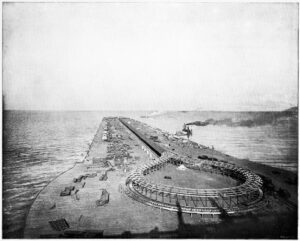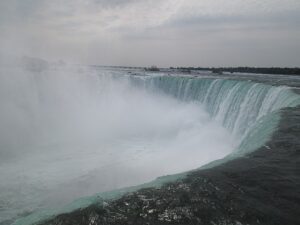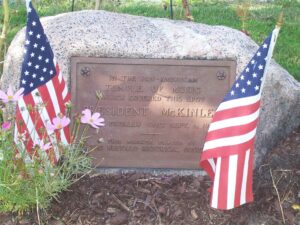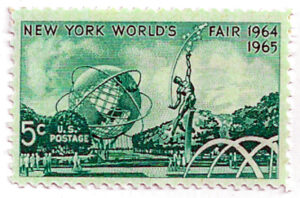News of Toshiba
On August 7, 2023, the news that “Toshiba will go private” hit the media.
In the first place, Toshiba’s recent straying has continued since the discovery of accounting fraud in 2015, but if you trace it back, there are many views that it started with the acquisition of Westinghouse, an American company in 2006.
You can see Toshiba’s anguish over the acquisition of Westinghouse, which has strengths in nuclear power plants, from various articles.
However, Westinghouse itself is still in business even though the shareholders have changed in various ways after going bankrupt.
Westinghouse and the World’s Fair
In fact, Westinghouse was a prestigious company that exhibited at the World Expos and left behind various topics.
Westinghouse was founded in 1886 by George Westinghouse (1846-1914), who was born in New York, USA.

ジョージ・ウェスティングハウス
George Westinghouse
George Westinghouse was an inventor.
His first patent was in 1865, when he was 19 years old, for his invention of the rotary steam engine.
In 1869 he invented a railway braking system using compressor air.
Along with that, he founded the Westinghouse Air Brake Company.
In 1886, he founded the Westinghouse Electric Company.
Edison and Westinghouse’s “War of the Currents”
At that time he adopted the AC electricity system.
Around this time, he collaborated with Nikola Tesla (1856-1943), from whom Elon Musk’s electric car company’s name “Tesla” was derived, and competed with Thomas Edison (1847-1931) , who was also a great inventor, and was promoting the DC power transmission.
They were fighting the “War of the Currents” between AC and DC.

トーマス・エジソン
Thomas Edison

ニコラ・テスラ
Nicholas Tesla
Tesla was born in what was then the Australian Empire to Serbian parents.
Then, after many twists and turns, he moved to the United States in 1884.
He originally worked for Edison’s lighting company, but he insisted on AC, and he quit because he disagreed with Edison, who insisted on DC.
Westinghouse supported and collaborated with Tesla.
And so the “War of the Currents” got into full swing.
As a result, this “War of the Currents” was won by Westinghouse, and AC became the de facto.
1893 Chicago World’s Fair
The 1893 Chicago World’s Fair made the winners of this war widely known.
This Expo was held in a venue called “White City” and is famous for the world’s first giant “Ferris Wheel”.

「ホワイト・シティ」と呼ばれた万博会場
Expo Site called “White City”

大観覧車(フェリス・ホィール)
FerrisWheel
At this Expo, after a battle with Edison’s General Electric Company, Westinghouse’s AC electricity system was adopted, and Westinghouse lit up the venue with 500,000 lights.
Westinghouse also exhibited two-phase AC generators and distribution systems.
On the other hand, Edison’s General Electric Company was defeated in the electric system, but exhibited and operated a “moving walkway” at the casino wharf that protruded into Lake Michigan in the Expo site.

グレート・ウォーフの「動く歩道」
The Great Wharf, ’Moving Sidewalk’
1901 Buffalo World’s Fair
Then, in 1895, Westinghouse installed a hydroelectric alternator at Niagara Falls, making it possible to provide large-scale, cheap electricity to Buffalo, New York.

ナイアガラの滝
Niagara Falls
The 1901 Buffalo World’s Fair was held to commemorate this event.
The exposition was originally planned for 1899.
However, in 1898, the Spanish-American War broke out between the United States and Spain over Cuba.
In 1899, the United States entered the Philippine War with the Philippines.
As a result, the event was postponed to 1901.
This Expo is also remembered for the assassination of President McKinley (1843-1901) at the Expo site.

レオン・チョルゴッシュが隠し持ったリボルバーでマッキンリー大統領に発砲する瞬間
Leon Czolgosz shoots President McKinley with a revolver concealed under a cloth rag. Clipping of a wash drawing by T. Dart Walker.

マッキンリー大統領暗殺を伝える石碑
The assassination site as it appears today
1939/40 New York World’s Fair
The next time the Westinghouse Company appears in the history of the Expo was in 1939.
The 1939/40 New York World’s Fair was held to commemorate the 150th anniversary of the inauguration of George Washington, the first president of the United States, who took office in 1789.
The Expo was held at what is now called Flushing Meadows-Corona Park in Queens. In terms of location, it is near the current La Guardia Airport, and was originally a swampy landfill called the Corona Dump.
The venue was vast, with an area of about 500 hectares, which was the second largest in the history of the World Expo (at that time), just short of the 1904 St. Louis World’s Fair (508 hectares).
Redevelopment of this area as a park was one of the objectives of the Expo, and if the Expo made a profit, the $2 million would be preferentially allocated to the park’s development funds.
The Expo was held for two years from April 30 to October 31, 1939 and May 11 to October 27, 1940.
The theme is “The World of Tomorrow” (1939) and “For Peace and Freedom” (1940) .
“Triron”, a triangular pyramid boasting a height of about 210 meterswith a huge sphere “Perisphere” with a diameter of about 60 meters were the symbol.
This “Trilon” and “Perisphere” were created by Henry Dreyfuss (1904-1972), a popular industrial designer at the time who created Hoover’s streamlined vacuum cleaner and the New York Central Railroad’s bullet-shaped train “20th Century”. It was hand made.

ペリスフィア(左)とトライロン
Perisphere (left) and Trilon
Inside the “Perisphere”, a panorama named after the theme exhibition “Democracity” was developed, which is an image of a future metropolis with a working population of 250,000 and a population of 1 million. was.
Also, at this Expo, many near-future technologies such as “television”, “nylon fiber”, and “color photography” were developed.
Robot “Electro”
And Westinghouse exhibited a robot at this expo.
The humanoid robot, Elektro, was about 2.4 meters tall and could walk, talk, see, sing, smell, count, and raise and lower its arms.
According to the company’s website, which can still be seen today, the following description can be found:
*
Elektro, the walking, talking robot. He could walk by voice command, speak about 700 words, smoke cigarettes, blow up balloons, and move his head and arms.
*
“Electro” was accompanied by a robot dog “Sparko” during the 1940 exhibition, and was a hit with children.

エレクトロとスパーコ
Elektro and Sparko
A “time capsule” that must not be opened until 5000 years from now
Also, at the New York World’s Fair, Westinghouse gained a reputation for its project of burying a “time capsule”, which was not to be opened until 5,000 years from now, about 15 meters below the site of the World’s Fair.
In fact, the time capsule was also born at the Expo, but the world’s first time capsule did not appear at this Expo. (For details, refer to chapter 58 of my book “EXPO 100 Stories1851-2025“)
However, although it was not the “world’s first time capsule”, this project was very popular.
This time capsule was to be buried on the site of the “Westinghouse” Pavilion on September 23, 1938, the year before the World’s Fair, six months before the opening of the New York World’s Fair.
Its shape is a long, narrow cylindrical rocket with a length of 2.18 meters and a diameter of 20 centimeters. Inside it, microfilm of “Britannica”, banknotes, playing cards and how to play them, an electric razor, etc. are stored. buried in

ウェスティングハウスのタイムカプセル(1938年)
Time Capsule of Westinghouse (1938)
1964/65 New York World’s Fair
Since then, time capsules have become popular at expos.
It was at the 1964/65 New York World’s Fair.
This New York World’s Fair was held as an independent World’s Fair, not an official World Exposition of the BIE, due to domestic competition with Seattle in hosting the World Expo. Like the 1939/40 New York World’s Fair, it was held for two years at Flushing Meadows-Corona Park, and was a large-scale World’s Fair with a total of over 51 million visitors.
The 140-foot-high (approximately 42.7 meters) object called the “Unisphere”, which was the symbol of the Expo, itself symbolized the “Space Age.”
This “Unisphere” is the work of American landscape architect Gilmore Clarke (1892-1982). Three gigantic rings surround the outside of a sphere that represents the Earth. It symbolizes satellites. The 900,000-pound (408-tonne) steel object was the world’s largest model of the Earth, and the steel was donated by U.S. Steel. The amount was $2 million (at the time).

『ユニスフィア』
“Unisphere”

『ユニスフフィア』。右の彫刻は『ロケット・スローワー』
“Unisphere”. “The Rocket Thrower” (by Donald De Lue) on the right
About 80 countries participated in the Expo, and there were 14 private pavilions, including 4 that were designed by Disney.
Now, for the 1964/65 New York World’s Fair, Westinghouse once again planned a time capsule similar to the 1939/40.
What to put in the time capsule at this time was democratically selected, including the selection by the selection committee and the opinions of the Expo visitors.
And on October 16, 1965, it was buried next to the 1938 time capsule.
Among the items buried at the time were bikini swimsuits that were popular at the time, Polaroid cameras, electric toothbrushes, ballpoint pens, transistor radios, contact lenses, Beatles records (!), and an official guide to the New York Expo.
*
In this way, Westinghouse has provided a lot of topics at the Expo.
Will there be another day in the future when Westinghouse will provide a great topic with the Expo?



